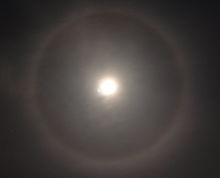- 22° halo
-
A 22° halo is a halo, one type of optical phenomenon, forming a circle 22° around the sun, or occasionally the moon. It forms as sunlight is refracted in hexagonal ice crystals suspended in the atmosphere. As the light beam passes through two sides of the prism forming a 60° angle, the angle of minimum deviation is almost 22° (namely, 21.84° on average; 21.54° for red and 22.37° for blue). This wavelength-dependent variation in refraction causes the inner edge of the circle to be reddish while the outer edge is bluish.[1] A 22° halo may be visible on as many as 100 days per year.[2]
 22° halo around the Moon
22° halo around the Moon
Light passing through the hexagonal ice prisms is deflected twice, which produces deviation angles ranging from 22° to 50°. Lesser deviation results in a brighter halo along the inner edge of the circle, while greater deviation contribute to the weaker outer part of the halo. As no light is refracted at smaller angles than 22° the sky is darker inside the halo. [3] This effect is similar to Alexander's band, which lies between primary and secondary rainbows. [4]
22° halos form when the sky contains millions of variously oriented (poorly correlated) ice crystals. Some of these happen to be aligned perpendicular to the sun's light as viewed by any given observer, which produces the illuminated 22° circle, while other crystals produce the same phenomenon for other observers.
Like other ice halos, 22° halos appear when the sky is covered by thin cirrus clouds containing the ice crystals that cause the phenomenon. Small colourful coronas much nearer the sun produced by water droplets can occasionally be confused with 22° halos. [5]
See also
References
- ^ Carl R. Nave (?). "The 22° Halo". Georgia State University. http://hyperphysics.phy-astr.gsu.edu/hbase/atmos/halo22.html. Retrieved 2007-04-18.
- ^ German research cited in The Cloud Collector's Handbook Gavin Pretor-Pinney ISBN 978-0-340-91943-9
- ^ Les Cowley (?). "22° Halo Formation". Atmospheric Optics. http://www.atoptics.co.uk/halo/circ1.htm. Retrieved 2007-04-15. (Including excellent illustrations and animations.)
- ^ Les Cowley (?). ""Disk with a hole" in the sky". Atmospheric Optics. http://www.atoptics.co.uk/halo/circ2.htm. Retrieved 2007-04-15.
- ^ Les Cowley (?). "22° Circular halo". Atmospheric Optics. http://www.atoptics.co.uk/halo/circular.htm. Retrieved 2007-04-15.
External links
Categories:- Atmospheric optical phenomena
Wikimedia Foundation. 2010.

